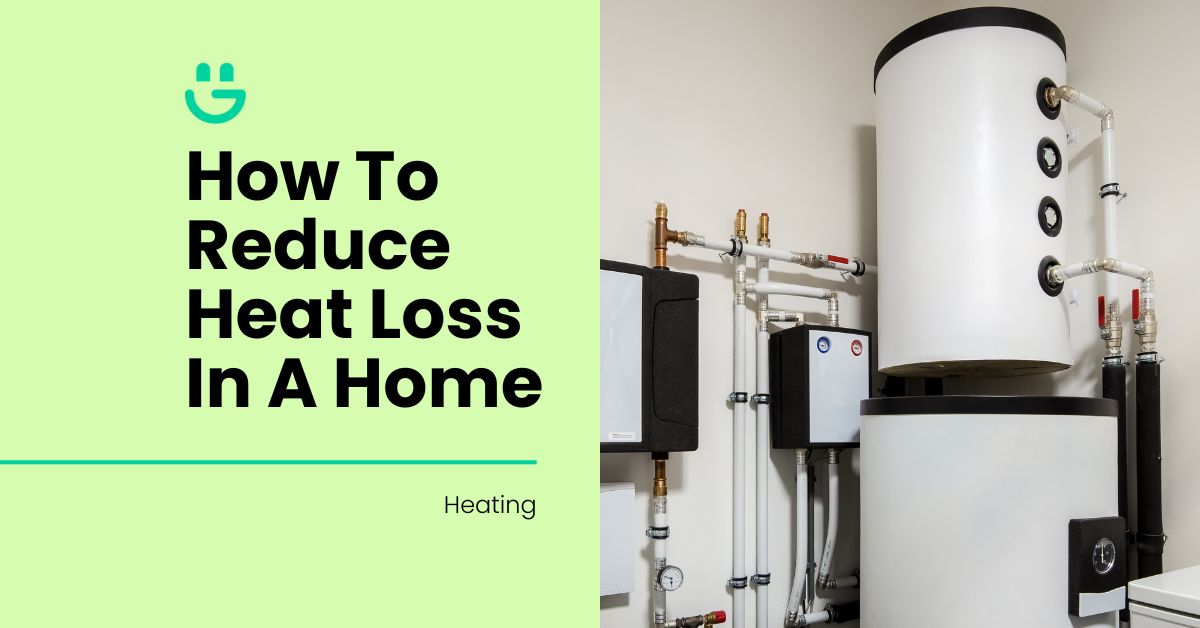Last Updated on March 18, 2025
The easiest ways to reduce heat loss in your home are to install double-glazed windows, insulate your home, and use energy-efficient heating solutions.
Keeping your home warm can feel like an uphill battle, leaving you shivering and frustrated.
But what if we told you there’s a way to reclaim control, banish the chill, and save money in the process?
This guide is your secret weapon to keep the winter blues – and heat loss – at bay. Forget cranking up the thermostat and embrace the energy-efficient era.
We’ll offer loads of practical, actionable tips and tricks, so you can transform your home into an energy-efficient, cost-saving haven.
Whether you’re a seasoned homeowner or a first-time renter, there’s something for everyone. And you’ll become an energy-efficiency champion in no time!
Contents
The Role Of Double Glazing In Reducing Heat Loss
Double glazing is one of the ways to minimise home heat loss. Double glazing for heat retention keeps energy bills low and diminishes your carbon footprint.
How it works
- Double glazing works by creating a barrier that helps maintain a consistent temperature inside the house, reducing the need for additional heating.
- Replace single-paned windows with glass that consists of two panels, separated by a vacuum or inert gas. The gap between the two panes is usually 16 mm. Installing this simple yet effective barrier hinders heat transfer between warm inside air and cold air from outside.
- According to the Energy Saving Trust, A-rated double pane windows can save £165 and 375 kg of carbon dioxide (CO2) per year!
Cost of double glazing installation
The average cost of double glazing in the UK is as follows*:
- 3-bedroom home (with 10 windows) = £4,000 – £7,000
- 4-bedroom home = £6,500 – £10,000
- Smaller homes with 4 – 6 windows = £1,500 – £4,000
- Larger building with 20+ windows = £8,000 – £12,000
- Cost of installation = between £200 and £500 per window
*Pricing can vary based on several factors, such as the size of your home, the number of windows, and the materials used for the window frames.
Guideline to costs of double glazing based on frame styles and materials:
- PVC window = £600
- Tilt and turn window = £800
- Aluminium frame = £900
- Timber frame =£1,000
- Sash window = £1,000
- Bay window = £1,500
Pro tip: Take advantage of UK Government-backed heating schemes like ECO 4 which provides free double-glazing installations for qualifying households. The scheme runs until 31 March 2026.
Is double glazing worth it?
Ultimately, the decision depends on your budget, priorities, and home situation. While the initial cost might seem high, consider the long-term benefits of energy savings, increased comfort and the advantage of using government heating schemes to offset installation costs.
In our opinion, double-glazed windows are a worthwhile investment and can increase the value of your property by about 10%.
Here are a few other benefits:
- Reduces heat loss by up to 25% – 30%.
- A-rated double-glazed windows minimise energy consumption, reduce carbon emissions (375 kg CO2 per year) and save up to £165 on annual heating bills.
- A++ double-glazed windows can result in £180 and 410 kg of CO2 savings per year. Over 10 years, this amounts to £1,800!
- Warm, cosy homes create a more comfortable living environment, eliminating cold spots and draughts.
- Helps lower UV rays and contributes to 19% – 57% noise reduction.
- Well-maintained glazed windows can last for 25 to 30 years.
If you’re interested in knowing more about heat loss in your home, check out Eco Happy’s website. But for now, let’s see what other methods can be used to side-step heat loss in UK houses.
5 Alternative Methods To Reduce Heat Loss And How To Implement Them
While double glazing has its benefits, it’s only one piece of your home’s thermal efficiency puzzle. Here’s a list of cost-effective home heating solutions to tackle heat loss and create a more energy-efficient home.
1. Insulation is key
Loft insulation
- Around 25% of heat escapes through uninsulated roofs and lofts.
- Loft insulation is often the most impactful and cost-effective heat retention option.
- Adding or topping up your loft insulation material creates a cosy barrier between your living space and the cold exterior.
- The UK Government recommends an insulation thickness of 270 mm.
- Loft insulation can potentially save £590 on annual heating bills (in detached houses) and last for around 40 years.
Cavity wall insulation
- Around 35% – 40% of heat is lost through uninsulated walls, including cavity walls.
- Most modern homes built before the 1990s have cavity wall insulation.
- Installing cavity wall insulation is a simple process and involves blowing insulating material – like foam or mineral wool insulation – to fill the cavity (gap) between interior walls.
- Proper insulation can result in 35% energy savings, amounting to roughly £800 per year in detached properties.
Floor insulation
- 10% of heat is lost through poorly insulated flooring.
- Insulating floors can reduce heat loss and improve the energy efficiency of your home.
- Spray insulation material, like foam, underneath suspended flooring (e.g. wooden floorboards) to stop draughts and prevent heat loss in your home.
- For solid floors, ensure insulation materials are installed before new floor coverings are put into place to prevent any dampness issues.
Note: You’ll need professional services for the above insulation methods.
2. Draught proofing solutions
- Seal gaps around windows and doors using a silicone sealant, draught strips, or door flaps.
- Install letterbox guards to prevent cold air from entering your home.
- Use keyhole covers to block draughts around keyholes.
- Add draught-proofing materials under internal doors to prevent heat from escaping to unused rooms.
- Seal unused chimneys and fireplaces to prevent heat loss through flue cavities.
3. Heating system efficiency
- Ensure your heating system and boiler are serviced at least once a year to ensure optimal performance and efficiency.
- Bleed radiators regularly to release trapped air and built-up debris and maintain system efficiency.
- Install programmable thermostats to control your heating system. We suggest lowering the temperature when you’re out or asleep.
- Thermostatic radiator valves regulate the temperature in individual rooms, preventing unnecessary heating in unused spaces.
Bonus tip: Read our How You Can Save On Your Electric Bill article next!
4. Smart thermostats
- Consider installing smart thermostats to boost your home’s efficiency and reduce energy bills.
- These smart devices can be programmed from afar, via mobile phones, and can automatically adjust temperatures throughout your house.
- While they have an initial cost, they offer significant long-term savings.
5. Behavioural tweaks
- Close internal doors to minimise heat loss.
- Open curtains during the day to allow natural sunlight to warm your home.
- Open windows and doors for short bursts to quickly ventilate your living space instead of leaving them open for extended periods.
- Turn the thermostat down by one or two degrees and opt to wear socks and jumpers indoors. This small adjustment reduces the demand on your heating systems, decreases heat loss, and saves money on heating bills.
- Opt for quick two-minute showers. Not only will you save energy and reduce the demand on your heating system, but you’re saving water too!
- Promptly repair or replace damaged infrastructure, like broken windows and seals, to limit warm air leakage.
- Remember, the most effective way to stop your home from losing heat is to use a variety of heat reduction methods. This creates a multi-layered defence against heat loss which positively influences your environmental impact and utility bills.
By implementing these tips into your daily routine, you’re on your way to a more energy-efficient and cost-saving home!
If you need more information on how to heat your home cheaply, chat with our experts at Eco Happy.
Understanding Heat Loss
Imagine turning up the temperature but the warmth seems to (literately) vanish into thin air!
Frustrating, we know.
Before you blame your heating system, let’s delve into the world of heat transfer and a few common culprits behind a chilly home and skyrocketing energy bills.
Studies show that UK homes lose three times more heat (3°C) than other European countries like Norway (0.9°C), Sweden (1.2°C), and Austria (1.2°C) after five hours.
Heat loss in homes is a critical factor affecting your home’s energy efficiency, especially in colder regions like the UK. Heat loss occurs when warm indoor air escapes to the outside environment, which in turn requires more energy to maintain a comfortable indoor temperature.
This process not only leads to higher heating bills but also has a significant environmental impact. Understanding the dynamics of heat loss is the first step towards implementing measures to enhance your home’s energy efficiency.
Here’s a list of five common heat loss areas:
- Walls – poor wall insulation accounts for 35% – 40% of heat loss in a home.
- Roof and lofts – sufficient loft insulation can save you up to 40% on energy bills.
- Windows and doors – poor insulation in windows and doors accounts for 25% – 30% of heat loss.
- Floors – account for roughly 10% of lost heat.
- Draught – older buildings can lose 15% – 20% of heat through insufficient draught proofing.
Heat always wants to escape to colder areas in your home. Heat lost to the outer environment happens through various pathways, such as:
Condensation
Visualise heat as thermal energy carried by microscopic particles in constant motion. When these particles encounter colder materials, like walls, windows and roofs, they transfer some of their energy (i.e. heat) to it.
This heat transfer causes the material to cool down and reduces the overall warmth within your home. This explains why a poor insulating material, like single-glazed windows, contributes to significant heat loss.
Convection
Heat naturally rises. In poorly insulated lofts, this warm air escapes directly into the atmosphere – taking your precious home heating with it.
Radiation
All objects, including walls, windows and doors, emit electromagnetic waves carrying thermal energy (i.e. heat). If the wavelengths emitted by these objects do not match the wavelengths of your heating source, radiation occurs. This is where double glazing comes into play, reflecting heat back into your living space.
By understanding these fundamental principles, you can pinpoint key areas where heat escapes and implement targeted solutions to combat this. Improving your home’s thermal efficiency will save energy, reduce heat loss, and put more money into your back pocket at the end of the day.
When To Consult Professionals For Heat Loss Reduction
Some heat loss home improvements, like sealing gaps around windows and bleeding radiators, are simple DIY tasks. While more complex methods, like cavity wall insulation or a boiler service, need professional intervention.
Here’s when to call in the professionals:
- Major insulation projects: As mentioned, complex tasks like cavity wall insulation, installing an underfloor heating system, installing double-glazed windows, or insulating solid walls need professional expertise. This ensures proper installation for maximum heat reduction.
- Smart thermostat installation: While some smart thermostats are user-friendly, consider professional services for complex systems.
- Boiler maintenance: Annual boiler and heating system services by a qualified technician are a must. They’ll ensure your heating system operates at optimum efficiency and prevent costly breakdowns and repairs.
By taking action and using professional services, you’re contributing towards a cost-effective, heat loss-free future!
Chat with Eco Happy
Chat with the experts at Eco Happy on how you can reduce heat loss in your home.
Our skilled team of plumbing, heating and installation professionals offer expert advice at a fraction of the cost, improving energy bills and heat loss across the UK.
Contact us today for a full analysis of your home’s current insulation and we’ll provide top tips on how to effectively reduce heat loss in your living space.
FAQs
What is the average heat loss of a house?
On average, poorly insulated UK homes lose heat via walls (35% – 40%), windows (25% – 30%), floors (10%), and lofts (25%).
What will reduce heat loss in my house?
Proper insulation is the most effective method to reduce heat loss in your home. Insulation creates a barrier between warm inside air and cooler exterior climates.
There are various types of insulation to reduce heat loss, such as solid wall, floor, loft, and cavity wall insulation.
What part of a home should I insulate first?
If you had to pick one area to insulate, opt for loft/attic insulation.
Final Thoughts
Who needs a roaring fire when you have this guide?
Banish cold air and say goodbye to skyrocketing bills! By following our tips, you’ll be transforming your home into a cosy haven before you can say “double glazing.”
Remember, to reduce heat loss in your home, small changes can make a big difference. Whether you opt for internal wall insulation or draught-proofing solutions, you’ll reduce air leaks and lower energy bills in no time!
Share your wisdom with friends and family, and let’s create a wave of energy-efficient homes across the UK. Together, we can turn the tide on rising energy costs and create a more sustainable future, one cosy home at a time.
Choose Eco Happy to make your home (and wallet) happy again!






James Elston
Boiler Expert
James Elston is the top boiler replacement and heating expert at Eco Happy. He has over 20 years of experience in the industry, focusing on Gas Safe boiler installations and offering home-heating and energy-saving solutions to homeowners across the UK. From sourcing the most energy-efficient combi boiler to providing specialist heating advice, James ensures that Eco Happy maintains the highest standards and best customer service.